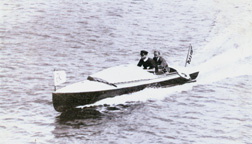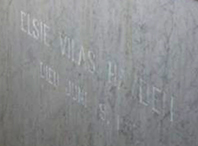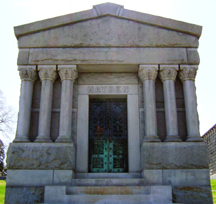
|
John
'Harold'
Hayden Sr. |
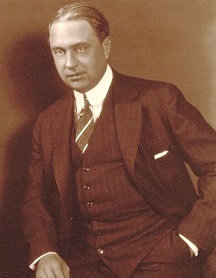 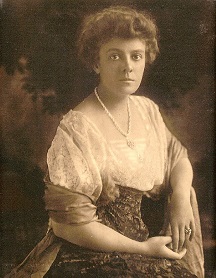 |
| Harold and Elsie (Vilas) Hayden - courtesy Marel Rogers |
John "Harold" Hayden Sr. was born in 1879 in Columbus, Franklin County, OH, the son of William Buck and Matilda (Langdon) Hayden.
Harold was a sailboat and motorboat racer and community philanthropist who apparently found only brief happiness during his relatively short life. He received a trust fund from the estate of his late millionaire grandfather, Peter Hayden, and it was administered by New Rochelle Trust Company.
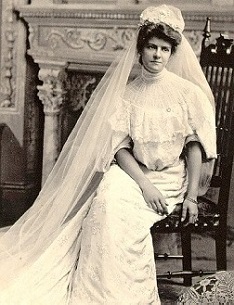
Courtesy Marel Rogers
His first wife, Elsie "Mit" Vilas (Oct. 18, 1880-1917), was the daughter of Royal Cooper and Carrie A. (Ward) Vilas, the father the president of the Pyle National Electric Headlight Company of Chicago. She was a star tennis player and an active volunteer with the American Red Cross during World War I.
Harold is mentioned in several books by Paul Malo, a historian of the Thousand Islands region and lifestyle in New York. One of Malo's books, the 2003 Fool's Paradise, states that the Hayden family "was perhaps the richest on the river -- they were over on Fairyland...." News stories of his era also referred to Harold and his brother Allen as "famed in the college world as premier football players..."
He grew up in Columbus and spent considerable time as an adult at Fairyland, the family's prominent summer vacation home in the Thousand Islands region of New York, near Alexandria Bay.
~ The Rafferty Marriage Disruption ~
Harold embarked in an unseemly piece of skulduggery in February 1901 which landed his name and story in newspapers across the country. He and his brother Allen traveled from New York to Alexandria Bay to watch the ice races at Redwood. During that trip, Harold spent time at the cottage of newlyweds George B. and Delorah (McIntyre) Rafferty and, according to reports, tried to break up their marriage. Rafferty's father, Gilbert T. Rafferty, had been a leading shareholder and president of McClure Coke Company in the Connellsville Coke region of Pittsburgh which was bought out by coke king Henry Clay Frick. As such, father Rafferty was very wealthy and owned two magnificent residences in the Thousand Islands, "Imperial Isle" and "Bonnie Castle." He also was commodore of the Thousand Islands Yacht Club and would have known the Haydens well. There were hints that father Rafferty objected to the son's marriage in the first place -- as he had married below his station to the daughter of a photographer known for his stereoviews of the various island mansions -- and secretly engaged Harold as an agent of disruption. A news story was published and widely reprinted, explaining what happened:
One morning, as [Mrs. Rafferty] was to start out on a shopping tour, she says Hayden suggested that he accompany her, saying that he had a confidential verbal message to deliver. They started for the market, and when opposite one of the public restaurants he invited her inside, where he might deliver his message undisturbed. When they had been seated and having ordered wine, Mrs. Rafferty says Hayden said to her: "If I can influence your husband to leave you it means $15,000 to me. If you assist me I will divide the amount with you. When he found that the money was no temptation to the woman and she resented his proposition, Hayden, she says, apologized and insisted that he meant no offense. They finished their wine and started out to complete the shopping. They had gone but a few blocks, however, when Mrs. Rafferty became dizzy and faint and finally completely collapsed, falling to the ground. She implored Hayden to go to her husband, but instead, she claims, he took advantage of her helpless condition and forced upon her improper attentions and afterward assisted her to her home and told her husband that she was in a beastly intoxicated condition.
Harold was arrested and a legal complaint filed against him in the county clerk's office in Watertown. He was brought before justice of the peace Willard Davis and was released when his father and uncle signed a $10,000 bond. In responding to reporters' questions, Harold only was willing to say that "I am being blackmailed, that's all."
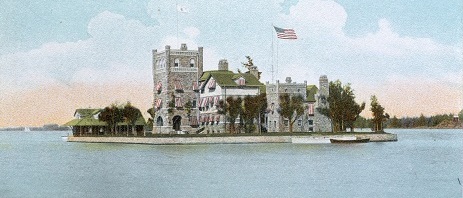 |
|
Magnificent Thousand Islands residence of Hayden friend G.T. Rafferty, the "coke-king" from Pittsburgh |
Circa 1901-1902, Harold studied at Cornell University, taking courses in mechanical engineering, but apparently the experience did not hold his interest. He discontinued his studies at or before the end of the spring term.
Like the Haydens, Emily's Vilas family maintained an attractive summer residence on the St. Lawrence River, known as "Imperial Isle." Their engagement was announced in the New York Times on Aug. 31, 1902, as well as in the New York Evening Telegram and Rochester Democrat. Just a few days after the engagement announcement, the news about the Rafferty matter became public.
But the controversy ultimately did not prevent the couple's' nuptials from taking place. Eight months later, on May 2, 1903, they were joined in matrimony in a "brilliant wedding" in Chicago's St. James Episcopal Church. In reporting on the happy event, said the Times, "Green and white was the color scheme, the combination being carried out in the church and house decorations, as well as in the costumes of the bridesmaids. The bridal party included Allen Hayden of New York, brother of the bridegroom, best man. Among the bridesmaids was Mabel Seaman of Brooklyn. N.Y.; and among the ushers was W.W. Wright of New York... The reception as the home of the bride's parents following the ceremony was a large one, several hundred guest having been asked." The Times added that the newlyweds would reside in Albany. They also maintained a home in late 1903 in New York City at Riverside Drive and 97th Street.
The Rafferty matter continued to surface from time to time early in the Hayden marriage. Delorah amended her complaint in August 1903 in Watertown to say that Harold indeed had alienated her husband's affections, and was now seeking $25,000 in damages. The case finally went before the Supreme Court on Nov. 27, 1903. After some delay, it was settled in June 1904, with the Rafferty lawyers only saying to the press that "Hayden paid heavily."
But Delorah was not yet finished, even as her husband left home and was away serving a three-year term in the Army, with a deployment to the Philippines. In August 1906, she sued her father-in-law for a cool $500,000 in damages. The father-in-law, who kept an apartment in the Waldorf Astoria Hotel, was quoted in the New York Evening World saying that "I shall never settle and so far as my boy is concerned he will have to continue to shift for himself, as he has since his marriage to this woman. I am done with him, and she will never get a penny of my money." That Evening World article included photographs of Delorah and her estranged husband. The case continued in February 1907 at a Special Term of the Supreme Court. It was finally thrown out of court in July 1908 when an old newspaper clipping was discovered showing that Delorah had compromised her legal position a few years earlier.
~ Harold and Elsie and Their Family of Three ~
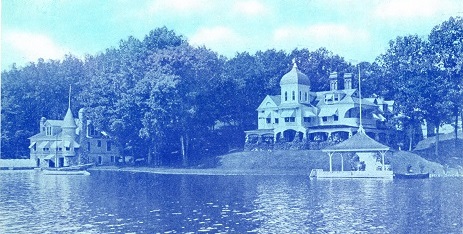 |
|
Fairyland, the Hayden family summer home, in an early blue-tint postcard |
Harold and Elsie went on to bear a trio of children -- Col. John Harold "Jack" Hayden Jr., Eleanor Hayden, M.D. and William B. Hayden II.
Fool's Paradise says that Elsie "was a noted tennis player..." Even after their marriage, circa 1913, she continued to compete -- and win -- in the annual tennis tournament held on the courts of the Thousand Island Yacht Club.
Elsie's brother Jack Vilas was "a well known aviator and society man," said the Watertown Daily Times. In June 1914, the Times reported that Jack was "not expected to be at the Thousand Islands this summer. Mr. Vilas was married during the past year and he and Mrs. Vilas will remain at Chicago, where Mr. Vilas expects to participate in several aeroplane contests. His brother, 'Billy,' however, is now at the Thousand Islands as a guest of J.H. Hayden."
 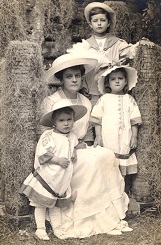 |
| Elsie and the children, 1908 (left) and 1911 - courtesy Marel Rogers |
John is believed, in the winter of 1901-1902, to have commissioned the design and construction of a houseboat named Lysander. Considered of the scow type, it was 85 feet long, 21 feet wide and had a draft of 52 inches. The vessel contained five staterooms, two baths, servants quarters, electric lights and hot water heat. In a report published in Houseboats and Houseboating, designer R.W. Haddock wrote that it "has no power for propelling purposes and is intended for a floating home to be towed from place to place at will." Later, the Lysander was available for charter by outside parties. By the summer of 1941, it was owned by Col. K.W. Slauson, who was away serving at Hickam Field in Honolulu, and who turned over management to Captain Enoch Root of Alexandria Bay.
The Haydens were listed in the 1908 edition of the Social Register, New York, as residing with his parents at 150 West 59th Street. Later, they made their home on Second Avenue in Pelham, Westchester County, NY.
Displaying his love for the outdoor life, Harold took part in the annual trap shoot contest of the Alexandria Bay Yacht Club. It was held on the Wellesley Island farm of his friend/client Gerald T. Rafferty. In 1901, he finished second, behind J. Day Knapp of Chippewa Bay, and just ahead of S.H. Vandergrift of Pittsburgh. He also is believed to have competed in golf and tennis tournaments as well.
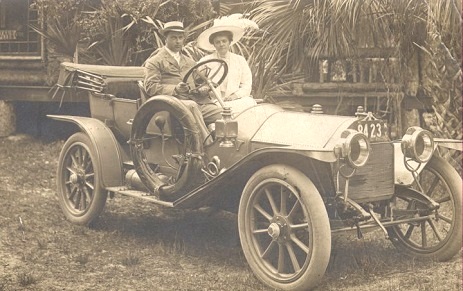 |
| Harold and Elsie readying for a motor outing - courtesy Marel Rogers |
|
|
|
A competitor motorboat, P.D.Q., 1911 |
Harold co-owned the Mit and Mit IImotorboats, which were christened with Eleanor's nickname and "considered among the fastest in the world," said the Buffalo Courier Express. Mit II was a rebuilt Bear Cat, described as a 20-foot hydroplane equipped with a 180-horsepower, eight-cylinder Sterling engine. Mit II won the race at Frontenac in August 1911 and Mit III captured victories in Thousand Island Yacht Club races circa 1912-1913. In 1912, his win brought the Gold Challenge Cup to the club, to be held for a year, in "one of the three greatest races in the world," reported the Watertown Daily Times. His victory in 1913 returned the prestigious race trophy to the club and generated headlines in the New York Times. In 1916, he drove the P.D.Q. IV to victory in a challenge cup race on the St. Lawrence River sponsored by the Thousand Islands Yacht Club, with his brother Allen serving as a judge, and they were mentioned in a related article in The Rudder. Seen here, a competitor boat, the P.D.Q, from a cover photo in March 1911 in Motorboat magazine.
When the federal census was taken in 1910, the Haydens made their residence in Pelham, and had four servants in the house. Harold's occupation that year was manager of an oil company.
Harold and Elsie are believed to have summered near Point Vivian, in the residence of Elsie's father. In 1915, while "not seriously ill [but] somewhat indisposed," said the Daily Times, Elsie and Harold decided not to spend the summer at Alexandria Bay. She "will not open her house, unless at the end of the season."
When World War I broke out, Elsie took active steps to play a patriotic role and support America's wartime effort. She organized a corps of the American Red Cross in Alexandria Bay. Reported the Watertown Daily Times, "She was instrumental in organizing the Red Cross chapter there and it was due in no small degree to he work that the Bay chapter did such valuable service. At her solicitation the millionaire colony contributed time and money. The chapter had unlimited funds with which to buy knitting machines and when the final accounting was made it was shown that outside Watertown, the Bay chapter had made the larges contribution to Red Cross work."
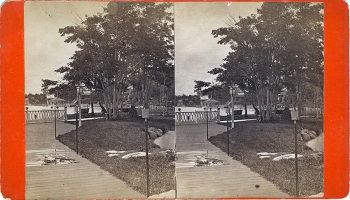
|
|
Stereoview of Hayden Island's boardwalk, on bright orange cardboard, published by A.C. McIntyre of Alexandria Bay. McIntyre produced 75 different negatives of the island. |
In their own response to the world war, Harold and his brother Allen both took an examination to become ensigns in the U.S. Navy, reflecting their expertise on the water.
Business directories
of the era show that Harold and his brother Allen were involved on the boards of several New York companies. Among these were Hayden Automatic & Equipment Company, of which Allen was president, and Harold secretary, with Allen, Harold and Elsie serving as directors. Offices were located at 26 Cortlandt Street, with the company's capital valued in 1908 at only $500. Also in 1908, the brothers were officers and directors of New York Vitak Company, located at 180 Lafayette, capitalized at $50,000. Other New York Vitak board directors were William E. Waddell and Thomas M. Hardesty.
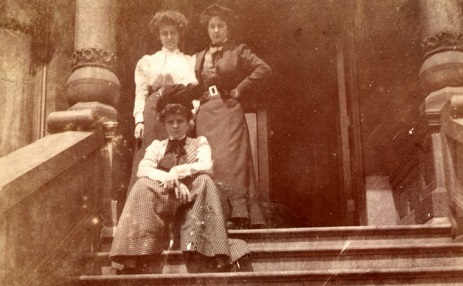 |
| Above: Elsie, seated, 1901, in Chicago. Below: Elsie tending a campfire in 1902 and with daughter Eleanor, 1908 - courtesy Marel Rogers |
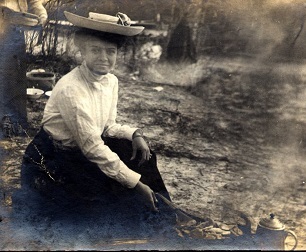 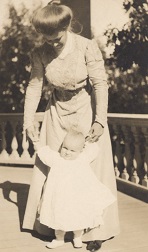 |
|
|
|
Kensico Cemetery |
Their final address together was 167 Secor Lane, Pelham Manor. Sadly, Elsie endured poor health for the last three years of her life. With John away in Newport, RI in training with the naval reserve, she was admitted to Dr. Ogilvie's private sanitarium in New York City in early June 1917. She passed away there suddenly on June 9, 1917, at the age of 36. Her funeral took place at the Hayden residence in Pelham Manor, officiated by Rev. H.H. Brown of the Church of the Redeemer. She was laid to rest in the Hayden family mausoleum at Kensico Cemetery in New York. The Mount Vernon Argus said that she "had a wide circle of friends and every one in the Pelhams held her in high esteem." Her crypt was inscribed with her name and date of death.
At the time of Elsie's death, Harold was away serving in the U.S. military. He returned home on a leave of absence. Her untimely demise left him a widower at age 38, with three motherless children under the age of 14.
In his mourning, Harold made a philanthropic promise to the American Red Cross at the Josiah Gilbert Holland Memorial Library, located on Market Street in Alexandria Bay. Reported the Watertown Daily Times:
As an expression of Mrs. Hayden's love for Alexandria Bay and its people, and also as a token of his own love for his late wife, Mr. Hayden has made arrangements to remodel and redecorate the Library hall, in memory of Mrs. Hayden. He will also install an adequate heating apparatus for the hall. The room in the future will be known as the "Elsie Vilas Hayden Memorial Room" of the Holland library and it is to be turned over to the Red Cross auxiliary, who will see to it that the room, as has hitherto been the custom, will be used by other patriotic organizations and for the benefit generally of Alexandria Bay. the room will be furnished in a manner suitable for Red Cross work, but later, when it is hoped the making of surgical dressings will not be necessary, Mr. Hayden will refurnish it in a suitable manner for use by the local charity and patriotic organizations.
Harold's generosity unfortunately led to controversy. While contractor John Brown had bid the job at $500, the actual bill was $1,200, which Harold considered excessive and refused to pay. Brown sued Harold for the difference, which led to local newspaper headlines and unwanted negative publicity. The Daily Times reported that the case would be tried at the state supreme court in Watertown, in the September Term 1916.
 |
| Above: Harold and his brother-in-law Jack Vilas on the Mit III, in about 1912-1913, named for Eleanor. Below: full throttle circa 1911 at the helm of the Mit II. |
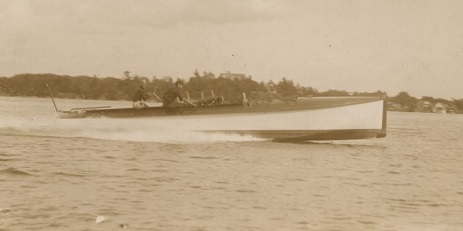 |
The philanthropic gesture was remembered for many years. In an article in Feb. 4, 1925, the Watertown Daily Times reported that "The second floor of the library was never fully furnished until 1917 when J.H. Hayden had them done over into the most complete Red Cross rooms to be found anywhere. This he did in memory of his wife, Elsie Vilas Hayden, who died shortly after the war broke out." Harold's sister in law, Ysabel (Pagels) Hayden, despite living in Columbus, was an ex officio member of the library board of directors, and may have persuaded Harold to offer his generous donation.
|
|
|
Kensico Cemetery |
Adding to the chaos and heartache, in what should have been a happier circumstance, Harold married again, to Josephine Morris Eddy (1881-1918). But during a late summer trip to Rideau Lakes, she contracted a fatal case of influenza. She died at New Rochelle, Westchester County, on Sept. 22, 1918, at the age of 37, leaving Harold a second-time widower in just two years. Josephine's remains were brought for eternal rest to the Hayden mausoleum at Kensico Cemetery. Her inscribed crypt is seen here.
Harold has not yet been located on the 1920 federal census, although they may have been in Canada at the time. Circa 1923, at the time his sister Alice French died, Harold lived on Hayden Island.
In 1922, the Catskill (NY) Recorder said that Harold and friend E.A. Brown had driven there to visit his brother Allen before embarking on a driving trip to California. Circa 1923, he and his son resided at the Hotel Westminster in New York City at 420 West 116th Street.
|
|
|
Hayden mausoleum, Kensico |
Harold is known to have spent the winter of 1930-1931 at the residence of William Truesdell in Ivy Lea, Canada.
Sadly, at the age of 51, Harold took his own life in the Truesdell home on April 30, 1931. The Associated Press coverage was widespread throughout the country, saying he had used a razor blade on his left wrist after "suffering from melancholia due to poor health." The Canadian Press Dispatch agency also distributed its own story throughout Canada.
His body was brought to Alexandria Bay for funeral preparations, and then shipped to New York City for placement within the family mausoleum at Kensico Cemetery.
A brief death notice was published in the New York Times and a more expansive obituary appeared in the Lowville (NY) Republican. His death also was noted in The Cornell Alumni News, saying he had taken a year of mechanical engineering at the school and "was prominent as a devotee of motorboat racing."
~ Son Col. John Harold "Jack" Hayden Jr. ~
Son Col. John Harold "Jack" Hayden Jr. (1904-1943) was born on April 16, 1904 in Manhattan, New York City.
John grew up in Pelham, Westchester County, NY and was an alumnus of Thornton-Donovan School and the Taft Preparatory School. He went on to earn a degree at Princeton University. John is known to have lived in New Rochelle, Westchester County, in 1931 at the time his father died. He would have been age 27 at the time.
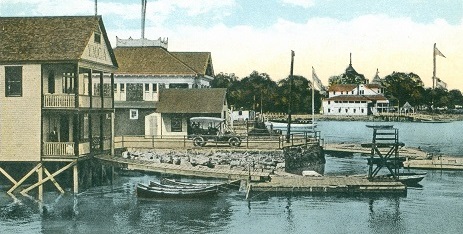 |
|
Boat house at New Rochelle |
He married Theresa (Brooks) Wood ( ? -1952). She had been married before and brought two stepsons into the union, Raymond B. Wood and Rodney Wood.
Together, the Haydens produced an only son, John Harold Hayden III.
John became an airplane pilot. He "flew extensively for many years prior to the war and was an aviation instructor in South America," reported a newspaper. Their home in the early 1940s was at Saranac Lake, NY.
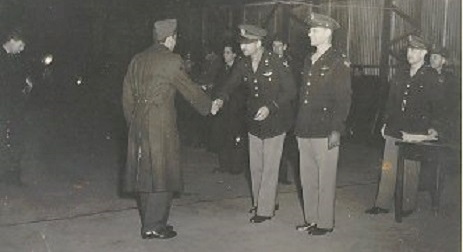 |
| Jack (center) awarding Air Force medals for heroism - courtesy Marel Rogers |
During World War II, John joined the U.S. Army Air Force and was given the serial number 0-311882. He attained the rank of colonel and in about 1943 was deployed to the European Theatre. While he was away, Theresa and their son moved to Tampa.
John was assigned to the London headquarters of the 8th Army Air Force, 93rd Group, 328th Squadron. His air exploits earned him a Silver Star in July 1943 for extraordinary achievements during a series of daring missions to destroy oil refineries in Ploesti, Romania, flying at very low levels just above the trees to avoid radar detection. He was pictured or named in several Tampa Tribune stories, presenting the Distinguished Service Cross medals to Air Force veterans for similar heroism in action.
| Jack's name, Tablets of the Missing, Cambridge American Cemetery, England Courtesy Kathy, Find-a-Grave |
According to sources, the B-24 heavy bomber in which John flew was considered a Liberator model and nicknamed "Wise Guy." On the fateful day of Dec. 22, 1943, he flew a mission to bomb railyards at Osnabrück, Germany. The plane was struck by enemy fire and anti-aircraft flak. Writing later, Air Corps Capt. Henri Z. Lake, an intelligence officer, said that the Wise Guy "had several large bursts hit close by, and then took evasive action, which consisted chiefly of violent turns. This scattered the formation. [It] was last seen at 5238N-0620E, at 1455 hours as it passed under the formation." The last person to have radio contact with the doomed aircraft was Capt. Robert H. McCaffery. Unable to regain control, the bomber crashed into the North Sea, west of the island of Texel, The Netherlands, with all hands lost.

oil refineries, Ploesti, Romania - Library of Congress
Word was telegraphed to Theresa in Tampa, and her husband's commanding general sent a separate note saying that eyewitnesses thought that John might be "possibly safe somewhere, that his plane may have reached occupied territory," said an account in the New Rochelle Standard-Star. She held out hope that he would miraculously return home and kept his uniform neatly stowed away in a closet.
But he eventually was declared killed in action, with his remains considered "nonrecoverable." Fellow crew members who perished with him were Capt. Herrel E. Ford, Capt. Lawrence C. Norman, 2nd Lt. Eugene H. Cantrell, 2nd Lt. Max M. Myres, Staff Sgt./tail gunner James W. Craig, Sgt. Otto Eckert, Sgt. Ward M. Randles and Sgt. James K. Kobler. John posthumously was awarded a Purple Heart and the French Croix de Guerre with Palm. His name is inscribed on the Tablets of the Missing at Cambridge American Cemetery in England. A classified Missing Air Crew Report was prepared and remained so until declassified in 1973 by the National Archives.
The widowed Theresa survived her husband by nine years. Her grieving was lessened a bit when her son Rodney returned home safely from wartime service. Mother and son enjoyed a little homecoming in Tampa on or about Dec. 1, 1945. But terror ensued when a lighted fireplace of her home at 3410 Mullen Avenue ignited and burned the roof of the dwelling. She and her son Rodney worked furiously to rescue clothing and furniture until the heat became unbearable. But her husband's uniform was lost. A photograph of a firefighter dousing an upstairs room appeared in the Tribune.
The day after Christmas 1946, Jack was named in a legal advertisement printed in the Catskill Examiner-Recorder as an heir-at-law of his late uncle, Cotton Allen Hayden. At the time, his address was given as 2524 Parkhurst Boulevard, Tampa, Florida.
As a widow, Theresa moved into the Parkland Apartments at 3211 Swann Avenue in Tampa. She was prominent in the Tampa Woman's Club and Tampa Symphony and served as president of the Hillsborough County Parent-Teacher Association, where she also chaired the organization's radio committee. The Tampa Tribune noted that for about two and [a] half years she wrote scripts for school broadcasts over WFLA, The Tribune station."
Tragedy further rocked this family when, while driving with her son John, the 53-year-old Theresa was killed in an automobile accident on April 12, 1952. Reported local newspapers, "her car left the road and crashed into a tree about 14 miles south of Ocala... Her son, John H. Hayden III, 12, received a concussion and possible fractured skull in the accident. State Patrolman C.S. Michael, who investigated the accident, said she was traveling about 70 miles an hour on State Road 2000 when the accident occurred." She was pictured in an account of the tragedy in the Tribune.
Son John Harold Hayden III (1939-2010) was born on July 8, 1939. At the age of 12, having already lost his father at war, he was orphaned when his mother was killed in an April 1952 automobile accident. John III was seriously injured in that wreck with a concussion and possible fracture of his skull, and was rushed to Ocala Memorial Hospital. He recovered and circa 1958 was a student at Florida State University. On May 31, 1980, at the age of 40, John was joined in wedlock with Mary Christine (Roebuck) Herrington (Dec. 25, 1930-2020), a native of San Augustine, TX and the daughter of Prentis and Winnie (Dickerson) Roebuck. They exchanged their vows in or near Houston, Harris County, TX, with their union enduring for three decades until the separation of death. Mary Christine brought three stepchildren into this marriage -- Sheila Bishop, Robert Herrington and Aldon Herrington. The Haydens made Houston their home over the years. Mary Christine earned a living as an oral surgeon assistant. Said an obituary. "She was a strong independent lady who was full of life. She was active at both Batson and Hardin Senior Centers. She enjoyed an occasional visit to the casinos [and] was a faithful servant who loved the lord." Sadly, John died in Cleveland, TX on May 5, 2010. Mary Christine outlived him by a decade and continued to dwell in Cleveland. She died in Humble, TX at the age of 89 on July 30, 2020. Brother Frank Liddell presided at the funeral, with interment following at Oak Grove Cemetery in Broaddus, TX.
- Step-granddaughter Sheila tied the marital cord with Dr. David Bishop Sr. They have lived in Humble, TX. David was a graduate of Lamar University and then obtained a master's degree. He first was assistant principal at Stephen F. Austin Middle School and Crockett Middle School in the Beaumont Independent School District. He eventually moved to French High School to become assistant principal, remaining to the end of the 1982 year, then taking an assignment at the rural Hampshire Fannette High School, while pursuing a doctorate at Texas A&M University. In 1983, he took the job of assistant principal at Humble High School. For 18 years, David served as principal of Humble High, while Sheila was employed at Riverwood Middle School as a secretary. He retired in 2003 at the age of 54, stating that student violence and heavy drug activity in the school made his job 95 percent police work, something he just did not enjoy.
- Step-grandson Robert Herrington entered into marriage with Doris. They settled at Moss Hill, TX.
- Step-grandson Aldon Herrington wed Kay. They put down roots in Beaumont, TX.
Stepson Raymond B. Wood joined the U.S. Army Air Forces during World War II and underwent officer training in Miami Beach. He made his dwelling-place in Springfield, OH in 1952. In time he settled at Stone Mountain, GA, and was there in 1997.
Stepson Irving "Rodney" Wood ( ? -1997) was born on (?). He served in the U.S. Army during World War II, with armament training at Buckley Field in Colorado. He received his discharge at Drew Field on the last day of November 1945. Rodney entered into marriage with Betty C. ( ? -2009). Together they produced one daughter, Rena Wood. He is known to have lived in 1952 in Jacksonville, FL. Later, the couple moved to Stone Mountain, GA. Rodney was the owner of Wood Realty Company. He held a membership in the Panthersville lodge of the Masons and Yaarab Tample, and was active with the Mounted Patrol and Sheriff's Posse of DeKalb County. In 1969, he was in the news when named to a DeKalb County authority to construct "a huge sports coliseum," reported the Atlanta Journal. Sadly, Rodney died on April 27, 1997. Rev. Luther Nance led the funeral rites. An obituary was published in the Journal in which the family requested that any memorial contributions be made to the American Cancer Society. Betty survived him for another dozen years. The angel of death cleaved her away in Emory Eastside Hospital on Sept. 6, 2009. The Atlanta Constitution printed an obituary.
- Step-granddaughter Rena Wood was in Stone Mountain, GA in 1997. She is believed to be the mother of Lance Miller.
Step-great-grandson Lance Miller wed Tracey. Their homeplace in the late 1990s was at Stone Mountain. Their pair of offspring include Chase Miller and Ansleigh Miller.
~ Daughter Eleanor Hayden, M.D. ~
Daughter Eleanor Hayden, M.D. (1907-1993?) was born on May 20, 1907 in Pelham Manor, Westchester County, NY.
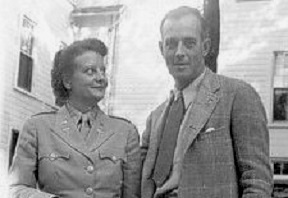
Eleanor graduated from the St. Mary's School in Peekskill, an Episcopalian convent, and in 1926 from Mount Vernon Seminary in Washington, DC. She made her home in the early 1930s in New Rochelle, Westchester County.
With encouragement from friend Christine Norman, pursued a career as an actress on Broadway over a run of eight years.
A short biography in the program book of "Your Uncle Dudley" (Cort Theatre, 48th Street East of Broadway, 1929-1930) said that she had "spent three years in stock before obtaining her first Broadway engagement in 'Philadelphia'."
In the stock theatre roles, said the Mount Vernon Argus, she "portrayed maids and all sorts of minor roles in which the lines were 'Yes," "No" and "Dinner is Served. In fact she played everything short of "Voices from Without and 'Steps on the stairs'."
Many years later, the Greenpoint Weekly Star said that she was "still remembered by veterans of the Great White Way for her performance opposite Walter Connolly in "Your Uncle Dudley" back in '29." The "Dudley" production was performed at the Cort Theatre, with Eleanor playing the part of Ethelyn Church.
The Brooklyn Daily Times reported in 1929 that she had:
...covered a great deal of ground both professionally and geographically in her young years on the stage. In those three years she has made her way through the rugged path of stock companies to a debut on Broadway as a leading woman... In the face of discouragement from her own family she took her career in her own hands and started it in her own way in a stock company in Zanesville, Ohio. The fortunes of a stock actress took her for engagements to Binghamton, N.Y.; Winnipeg, Canada; San Antonio, Texas; Paterson, N.J., and Norfolk, Va."
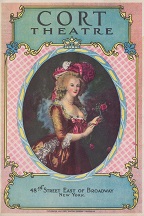 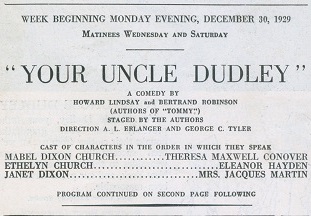 |
| Program booklet from the 1929-1930 Broadway play "Your Uncle Dudley" in which Eleanor played the part of Ethelyn Church to great acclaim |
She was discovered in New York in the spring of 1929 by Howard Lindsay and Bertrand Robinson, who were seeking a young girl for a new comedy about to open in Chicago's Illinois Theatre. Among her better-known performances was "Legal Practice" and "Philadelphia" (portraying Nellie Densford), both in 1929. She had a leading role in the 1931 mystery drama "The Ninth Guest" at the Garrick in Philadelphia (playing Jean Trent), in which she and Howard St. John were pictured in the Philadelphia Inquirer. She also tried her hand at songwriting, copyrighting the work "Dream Man" on April 14, 1931.

But in the iron grip of the Great Depression, there were fewer successful Broadway shows and quality roles to pursue. Three known plays in which she took part in 1932 were "How to Hold a Husband," "Red Kisses" and "Dangerous Love," staged by the Broadway Players in New Jersey. Faced with this reality, she gave way to a stronger call. Eleanor stepped away from the stage to become a nurse. She earned her pre-medical degree from New York University in 1936, and her medical degree in 1939 from NYU's College of Medicine. She served an internship at Ellis Hospital in Schenectady and then another in pediatrics at Bellevue Hospital. Eleanor was in Florida at the time of the Japanese attack on Pearl Harbor. She hastened to return to Brooklyn, closed her medical practice and gave up her work at Bellevue and "asked the Red Cross what she could do," said the Brooklyn Eagle. "Since last February she has been physician in charge of the Red Cross Mobile Unit."
Said the New York Times, in 1942, "She aided in organizing the Brooklyn Red Cross Blood Bank and was in charge of its Mobile Unit until she received her commission in December 1942 as a first lieutenant in the Medical Corps" during World War II. In departing for training at Fort Des Moines in Iowa, the Eagle said she was "believed to be the first woman doctor to join the Waacs." Her wartime service was in the Army Ground and Service Forces Redistribution Station in Lake Placid, NY.
In August 1944, her uncle W. Langdon Hayden announced in the New York Times that Eleanor was betrothed to Fernand M. d'Orbessan (Sept. 11, 1903-1975) of New York. At the time, Fernand was an alumnus of St. John's Preparatory School in Brooklyn and had studied at Lafayette College in Easton and was employed in Indianapolis by Eli Lilly & Company.
The day after Christmas 1946, Eleanor was named in a legal advertisement printed in the Catskill Examiner-Recorder as an heir-at-law of her late uncle, Cotton Allen Hayden. At the time, her name was "D'Orbessan" and her address was 1521 Unionport Road, Parchester, NY.
Two offspring were born to the couple - Frederick D'Orbessan and Marcel Rogers.
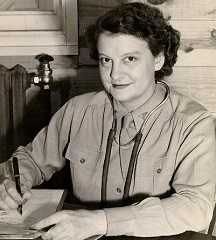 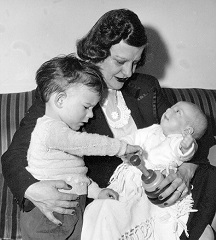 |
| Eleanor in her Army uniform and with her children - courtesy Marel Rogers |
Tragically, their son Frederick (Sept. 2, 1945-1956) was diagnosed with leukemia and did not survive childhood. He died at the age of 10 in 1956. Interment of his tender remains was in Long Island National Cemetery.
The D'Orbessans' marriage did not last, and Eleanor took back her maiden name. Fernand is known to have married again, to Martha A. Wilson (1898-1960), daughter of Elizabeth Johnson and widow of Thomas C. Wilson, who manufactured boiler tube cleaners. The second Mrs. D'Orbessan died on July 24, 1960, with an obituary carried in the Times.
Eleanor went into private medical practice and in 1949 became employed part-time with the city Health Department as a physician in the public schools. She continued in her practice until 1952. She then pursued a career shift as a health officer and in 1952 received a master's degree from the School of Public Health at Columbia University.
Eleanor maintained an office during the 1950s at 3-01 150th Street in Whitestone, NY. In 1953, she was a health officer in training for the New York City Department of Health and was assigned to the Williamsburg Health Center. She became director of the Center and held that position for some years. Among the top challenges she and her staff faced were "a rise in the incidence of tuberculosis, deaths of mothers in childbirth and infants in their first year," said the Weekly Star.
In 1959, she was pictured in a Weekly Star article about her stage-to-medical career path.
Eleanor died on April 27, 1993, with burial with her son at the Long Island National Cemetery in Farmingdale, Suffolk County, NY (Section C, site 262-B).
Fernand, also a World War II veteran, passed away on Jan. 30, 1975, and also is interred at the national cemetery in Farmingdale (Section C, site 259BB).
Daughter Marel D'Orbessan (1947- ? ) was born in about 1947. At the age of 12, she was enrolled in the Foxwood School in Flushing, NY. She went on to graduate from the Kent School in Connecticut in 1965 and Brown University in 1969. She was joined in wedlock with Clifford A. Rogers (1928-2015), a fellow Brown alum of the class of 1966. The couple made a home in Sharon, CT and were the parents of a daughter and two sons. Clifford was a teacher of classical Latin and Greek at St. Paul Academy in Minnesota, the Salisbury School in Connecticut and Tufts University. At Tufts, he also held the role of dean of admissions. In his free time, he liked to read and work with wood. Marel and Clifford were mentioned in a Nov. 25, 1998 story in the Wall Street Journal headlined "Some Find It More Pleasant Dining On Pheasant, Boar or Spaghettios." Sadly, having suffered a stroke, Clifford died on Aug. 1, 2015. Marel graciously has posted family information on Ancestry.com.
~ Son William Buck Hayden II ~
Son William Buck Hayden II (1908-1983)
was born on Aug. 9, 1908 in Pelham Manor, Westchester County, NY. Named for his grandfather, he was baptized at the age of three months on Nov. 22, 1908, in the Redeemer Episcopal Church of Pelham Manor.
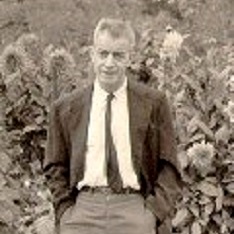
Courtesy Marel Rogers
He stood 5 feet, 10 inches tall and weighed 155 lbs., bearing a scar on his scalp. He was a painter and sculptor and moved to New Orleans in young manhood to pursue his art.
In the spring of 1930, William accompanied an expedition led by Tulane University professor Franz Blom to Uxmal, Mexico, in the quest to explore and document Mayan ruins. Said the Huntsville (AL) Times, he was a "member of several archaeological and anthropological expeditions and before going to Uxmal was engaged [in] archaeological research in Arizona..." William assisted Blom and others in taking measurements of one huge section known as the "Nunnery."
On July 30, 1930, back in New Orleans, William tied the marital cord with Alabama native Isolde Benz (Aug. 21, 1916-1965), daughter of Leonard and Sybil (Dolin) Benz. The wedding was held at St. George's Episcopal Church at the corner of Cadiz and St. Charles Streets, by the hand of Rev. Ira Lang, with no attendants. The newlyweds were introduced to each other by Enrique Alvarez, a sculptor in the New Orleans French Quarter ("Vieux Carre") who also was on the Uxmal trip.
Isolde was an artist in her own right and had grown to adulthood in Mobile. Reported the Huntsville (AL) Times, "The romance of Miss Benz and Mr. Hayden came into bloom in the picturesque-patios of the old Vieux Carre. Together they painted many pictures of courtyard scenes... For the next six months Mr. Hayden will be occupied in making plaster casts of objects, discovered at the Maya ruins of Uxmal for the 1933 World's Fair at Chicago." Literature for the Fair shows that the casts were used for exact reproductions of the Nunnery and exhibited at the 31st Street display along the lakefront.
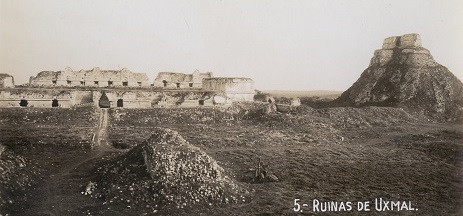 |
| Above: archaeological ruins of the nunnery at Uxmal, Mexico, which William visited and helped to map in 1930. Below, left: ornate carving detail at the nunnery. Right: reconstructed nunnery at the Chicago World's Fair, 1934. |
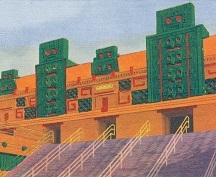 |
Today Uxmal is considered one of the most important Mayan archaeological sites and "most representative" of the the culture's dominant architectural style in the region. The United Nations Educational, Scientific and Cultural Organization (UNESCO) has designated it as a World Heritage Site.
The couple did not reproduce. Their first home was at 630 Ann Street in the city, with a second residence in New Rochelle, NY.
William went on to join the faculty of Tulane as a university archaeologist. But their marriage was troubled. He sued for divorce, accusing her of an improper relationship with Dr. Richard J. Czajkowski, a Polish diplomat, explorer, scientist and military veteran. A United Press story in August 1936 called Isolde "comely" and said she won the case in New Orleans Civil District Court with the judge rejecting William's divorce request. The UP story, published in Atlanta and Orlando, FL, went on to say that:
Dr. Czajkowski was deported last year when he overstayed the period allowed him by the government. Before he left, he denied undue relations with Mrs. Hayden and made a deposition saying he had a wife and daughter in San Francisco. In denying the decree, Judge Michael Provosty ended one of the most prolonged divorce proceedings ever recorded here. Witnesses for both sides included Tulane and Newcomb College for Women students and professors, French quarter artists and habitues, prominent socialites and relief workers. Two men were charged with perjury and an accident insurance ring was uncovered as side phases of the case. Plaintiff's counsel and an ERA executive had a fist fight when the ERA official refused information on the alleged co-respondent's connection with an archaeological project.
One of the witnesses in the case, E.A. Carlson, head of a claim adjustment agency, was jailed for perjury on the stand.
Regardless of the legal outcome keeping their union intact, the Hayden's relationship was irrevocably broken. He returned to New York City, while she went back to Mobile and stated that she was a widow in the 1936 Mobile City Directory. She thereafter used the name "Isolde Mauk" and seems to have remained in Mobile for the balance of her life, with an address at 262 Roper Street. On a tragic day in March 1965, her nightgown caught fire when she backed into an open space heater. She received second- and third-degree burns over a third of her body and taken to Brooke General Hospital at Fort Sam Houston in San Antonio, TX. There, she lingered for 35 days and developed acute bleeding of the pancreas with additional infections of peritonitis and septicemia. On April 30, 1965, at the age of 53, death mercifully spirited her away. The remains were returned to Mobile for interment in Magnolia Cemetery.
In 1940, when registering for the military draft during World War II, William declared himself self-employed and gave his address as 16 East 92nd Street in New York City.
William joined the U.S. Armed Forces during the war and, holding the rank of sergeant, was deployed to the Pacific Theatre. He was honorably discharged on Oct. 24, 1945.
The day after Christmas 1946, William was named in a legal advertisement printed in the Catskill Examiner-Recorder as an heir-at-law of his late uncle, Cotton Allen Hayden. At the time, his address was given as 25 West 16th Street, New York City.
At some point William resided in Missouri, likely in Kansas City. His last residence was on Staten Island, NY. How he spent those decades may be lost to history.
The grim reaper harvested away William on July 21, 1983.
The fate of his former wife is not known.
|
Copyright © 2009-2010, 2015, 2025 Mark A. Miner |
|
Kensico mausoleum photographs courtesy of Linda Burton Kochanov |
